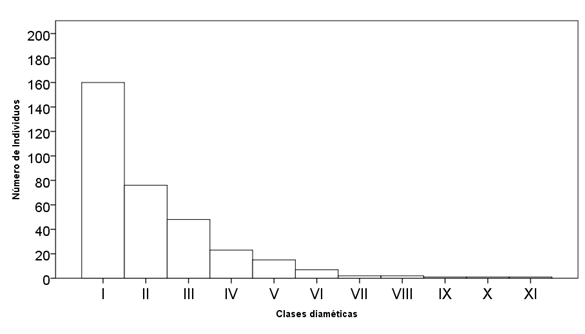Composition and diversity of tree vegetation, an instrument of tourism management, case: Lake Lagrio recreational ecological park (Perla) Sucumbíos- Ecuador
Main Article Content
Abstract
The present study focused on determining the composition and diversity of arboreal vegetation for tourism promotion purposes and generate technical information in which the attributes of the forest resource to carry out this activity are sustained. Ten transects of 10 x 50 m were established, data of all individuals ≥ 10 cm in diameter were taken at breast height, and forest wealth, structural characteristics, importance value indices and diversity indices were determined. An approximate of 672 individuals / ha was recorded. grouped into 25 families, 37 genera and 42 species. The richest families are Meliacea, Lauracea, Mimosaceae. The forest presents a basal area of 39,4 m2 / ha; and a volume of 255,3 m3 / ha. The species with the highest importance value index are Guareakunthiana, Ingaspp, Nectandraguadaripo, Pourouma minor, Chrysophyllumargenteum, the upper stratum is represented by Pourouma minor,Vochysiaferruginea and Dussialehmannii the stratum co-dominated by Guareakunthiana, Miconia sp. Nectandraguadaripo and the stratum suppressed by Simaroubaamara, Virolaelongata. The trees are grouped into 11 diametric classes, of which the first three cover the largest number of individuals (84.5%). The diametric distribution is formed by young and thin individuals. According to the attributes and structural characteristics of the forest, it was determined that the study area has exceptional features, capable of motivating on its own or in conjunction with other contiguous attractions, a current or potential current of national or foreign visitors.
Downloads
Article Details
References
AGUIRRE MENDOZA, Z. y GEADA-LOPEZ, G., 2017. Estado de conservación de los bosques secos de la provincia de Loja, Ecuador. Arnaldoa [en línea], vol. 24, no. 1, pp. 207-228. [Consulta: 10 septiembre 2018]. ISSN 2413-3299. DOI 10.22497/arnaldoa.241.24107. Disponible en: http://www.scielo.org.pe/scielo.php?script=sci_abstract&pid=S2413-32992017000100007&lng=es&nrm=iso&tlng=es.
BEALS, E.W., 1984. Bray-Curtis Ordination: An Effective Strategy for Analysis of Multivariate Ecological Data. En: A. MACFADYEN y E.D. FORD (eds.), Advances in Ecological Research [en línea]. S.l.: Academic Press, pp. 1-55. [Consulta: 10 julio 2018]. Disponible en: http://www.sciencedirect.com/science/article/pii/S0065250408601683.
COTTAM, G. y CURTIS, J.T., 1956. The Use of Distance Measures in Phytosociological Sampling. Wiley on behalf of the Ecological Society of America [en línea], vol. 37, no. 3, pp. 451-460. DOI DOI: 10.2307/1930167. Disponible en: https://www.jstor.org/stable/1930167.
DONAIRE, J.A. y GORDI, J., 2003. BOSQUE YTURISMO. Universidad de Girona [en línea], no. Boletín de la A.G.E. N.o 35, pp. 207-221. Disponible en: http://age.ieg.csic.es/boletin/35/3511.PDF.
GADMM, 2015. Mapa de la cobertura vegetal del canton Mera. 2015. S.l.: s.n.
GARCÍA, J.I.R. y DÍAZ, M.M., 2007. Los indicadores de sostenibilidad en el turismo. Revista de Economía, Sociedad, Turismo y Medio Ambiente: RESTMA [en línea], no. 6, pp. 27-62. [Consulta: 13 septiembre 2018]. ISSN 1698-8280. Disponible en: https://dialnet.unirioja.es/servlet/articulo?codigo=2660058.
INAMHI (INSTITUTO NACIONAL DE METEOROLOGÍA E HIDROLOGÍA), 2017. Datos históricos, anuarios meteorológicos. [en línea]. Ecuador, Quito: INAMHI. Disponible en: http://www.forosecuador.ec/forum/ecuador/educaci%C3%B3n-y-ciencia/35393-inamhi-anuarios-metereol%C3%B3gicos-en-pdf.
LAMPRECHT, H., 1990. Silvicultura en los trópicos: los ecosistemas forestales en los bosques tropicales y sus especies arbóreas; posibilidades y métodos para un aprovechamiento sostenido. S.l.: TZ-Verlag-Ges. ISBN 978-3-88085-440-6.
MAGURRAN, A.E., 1988. Ecological Diversity and Its Measurement [en línea]. S.l.: Springer Netherlands. [Consulta: 13 septiembre 2018]. ISBN 978-94-015-7360-3. Disponible en: //www.springer.com/la/book/9789401573603.
MCCUNE, B. y BEALS., E.W., 1993. History of the development of Bray-Curtis ordination. En: J. T. CURTIS, Fifty years of Wisconsin plant ecology [en línea]. USA: Wisconsin Academy of Science, Arts and Letters, Madison, Wisconsin, pp. 67– 79. Disponible en: http://labs.russell.wisc.edu/landscape/fifty-years-of-wisconsin-plant-ecology/.
MINISTERIO DEL AMBIENTE DEL ECUADOR, 2013. Sistema de Clasificación de los Ecosistemas del Ecuador Continental. [en línea]. Quito, Ecuador: Subsecretaría de Patrimonio Natural. Disponible en: http://app.sni.gob.ec/sni-link/sni/PDOT/NIVEL%20NACIONAL/MAE/ECOSISTEMAS/DOCUMENTOS/Sistema.pdf.
MINTUR, 2016. Actualización sobre la estructura y servicios turísticos del terremoto 16-04-2016. Quito - Ecuador: MINTUR.
ORGANIZACION MUNDIAL DE TURISMO, 2008. Entender el turismo: Glosario Básico | Comunicación [en línea]. 2008. S.l.: Autor. Disponible en: http://media.unwto.org/es/content/entender-el-turismo-glosario-basico.
PATIÑO, J., LOZANO, P., TIPÁN, C., NAVARRETE, H., LOPEZ TOBAR, R., ASANZA, M. y TORRES, B., 2015. Floristic Composition and Structure of a Montane Evergreen Forest at 600- 700 mals in the Piatúa River Basin, Napo, Ecuador. Revista Amazónica Ciencia y Tecnologia [en línea], vol. Vol. 4, pp. 166-192. Disponible en: https://www.researchgate.net/publication/292964081_Floristic_Composition_and_Structure_of_a_Montane_Evergreen_Forest_at_600-_700_mals_in_the_Piatua_River_Basin_Napo_Ecuador.
VALLE, C., 2001. Técnicas de investigación en ecología. Material de enseñanza. 2001. S.l.: Colegio de Ciencias Ambientales. Universidad San Francisco de Quito.


